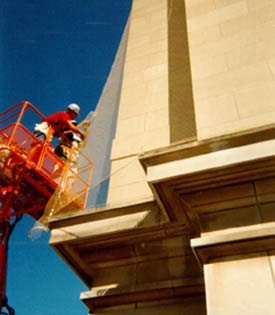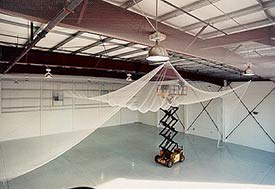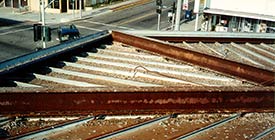Quick Links: The Problem with Pigeons | Pigeon Exclusion Systems | Client Pigeon Exclusion Projects | Pigeons Away | New Website
New Jersey Pigeon Control Services by Pigeons Away, a Division of Allison Pest Control
 Pigeons roosting on a building present as serious a health risk and carry as many dangerous diseases, pathogens and parasites as a colony of rats. Known vectors for numerous dangerous diseases, pigeons harbor disease-carrying parasites on their bodies and in their nests and spread harmful diseases through their feces. Their habit of living in extremely close proximity to humans makes pigeons a serious public health threat.
Pigeons roosting on a building present as serious a health risk and carry as many dangerous diseases, pathogens and parasites as a colony of rats. Known vectors for numerous dangerous diseases, pigeons harbor disease-carrying parasites on their bodies and in their nests and spread harmful diseases through their feces. Their habit of living in extremely close proximity to humans makes pigeons a serious public health threat.
Feral pigeons are found in every city in American in both urban and suburban environments. The pigeon's history has been tied to man since the Romans domesticated cliff-dwelling European rock doves more than 2,000 years ago. Over the centuries, pigeons have been both hunted and raised for food, domesticated as pets and trained to deliver messages. Humans have carried pigeons to every corner of the Earth where a wide variety of pigeon species thrive in all but the harshest climates. Not native to America, U.S. pigeons are descended from domestic homing pigeons brought to America in the 1600s by Europeans. Pigeons adapted readily to U.S. urban life and have become the country's No. 1 urban bird pest, doing millions of dollars in damage to urban areas every year.
Due to the health risk they pose and the precarious locations of their roosts, successful elimination of pigeons from your business requires the expertise of a pest control professional with demonstrated experience in pigeon exclusion. Allison Pest Control has been the recognized New Jersey leader in pigeon exclusion for decades. Allison Pest Control's separate division called Pigeons Away is a pigeon exclusion expert having the specialized knowledge, experience, safety gear and tools necessary to guarantee safe and effective pigeon exclusion without risk to human inhabitants of commercial buildings. Allison Pest Control's pigeon exclusion experts can rid your home or business of problematic pigeon pests and prevent pigeons from coming back.
![]() Diseases
that pest birds carry.
Diseases
that pest birds carry.
NJ Pigeon Identification
 Pigeons have large, compact bodies 12 to 15 inches tall with small heads set on short necks and weigh 10 to 16 ounces. Iridescent green and purple head and neck feathers set off their blue-gray bodies. Other distinguishing marks include a white rump and two broad black bars across each wing with a single dark bar across the end of the tail. Pigeons have short bills for pecking grain, and short legs with level front and hind toes that allow them to either perch on branches or walk across flat surfaces. Their distinctive head-bobbing gait helps with depth perception, a factor of their side-mounted eyes and monocular vision. Pigeons have large, strong wing muscles that allow them to fly long distances and reach flight speeds up to 82 mph.
Pigeons have large, compact bodies 12 to 15 inches tall with small heads set on short necks and weigh 10 to 16 ounces. Iridescent green and purple head and neck feathers set off their blue-gray bodies. Other distinguishing marks include a white rump and two broad black bars across each wing with a single dark bar across the end of the tail. Pigeons have short bills for pecking grain, and short legs with level front and hind toes that allow them to either perch on branches or walk across flat surfaces. Their distinctive head-bobbing gait helps with depth perception, a factor of their side-mounted eyes and monocular vision. Pigeons have large, strong wing muscles that allow them to fly long distances and reach flight speeds up to 82 mph.
But pigeons are just one of the birds that can considered being a pest bird. Find out which other types of birds qualify for pest bird status due to their habits and proclivity for carrying disease.
![]() Pest bird identification guide.
Pest bird identification guide.
Pigeon Behavior and Habitat
Feral pigeons mate for life. In winter, they build simple nests on small, flat surfaces off the ground. Nests may consist of no more than a few twigs and are most often built on building ledges, roofs, bridge supports, signs or wide window sills. In crowded flocks, pigeons may forego nests, laying their eggs directly on ledges. Eggs hatch in the spring, producing two "squabs," young pigeons that fledge and leave the nest in about two months. Non-migratory, pigeons spend most of their life near their birth site. Coupled with their determined personality, this can make pigeon exclusion challenging. Primarily grain eaters, pigeons may also feed on human food scraps.
Why are Pigeons a Pest Problem in New Jersey?
Pigeons harbor 40 parasites on their bodies or in their nests, including harmful disease-transmitting ticks, fleas and mites. Known vectors for disease, pigeons transmit several hundred dangerous viral and bacterial pathogens through their droppings, including salmonella, plague, encephalitis, pox and meningitis. Airborne spores from dried feces can settle on food and contaminate it. If these spores settle on open cuts or wounds, they can cause infection and even blood poisoning. When spores are breathed into the lungs, they can result in serious lung infections and respiratory problems. Researchers recently traced a deadly new strain of encephalitis to mosquitoes that had fed on infected New York City pigeons.
 Pigeons not only transmit disease, they cause millions of dollars in property damage every year. Uric acid in pigeon feces is highly corrosive and can cause serious damage to human structures, particularly building roofs and siding, rooftop machinery and air conditioners and parked cars. Roosting debris from large flocks of pigeons can build up in gutters and drains, causing them to back up, damaging roofs and other structures. Blocked roof top drainage systems have been known to cause serious leaks and even roof collapse. If trapped in production facilities, pigeon feces can be inadvertently mixed with product ingredients, ruining them, or, in the case of food processing plants, contaminating food products.
Pigeons not only transmit disease, they cause millions of dollars in property damage every year. Uric acid in pigeon feces is highly corrosive and can cause serious damage to human structures, particularly building roofs and siding, rooftop machinery and air conditioners and parked cars. Roosting debris from large flocks of pigeons can build up in gutters and drains, causing them to back up, damaging roofs and other structures. Blocked roof top drainage systems have been known to cause serious leaks and even roof collapse. If trapped in production facilities, pigeon feces can be inadvertently mixed with product ingredients, ruining them, or, in the case of food processing plants, contaminating food products.
When pigeons nest in commercial electric signs, highly flammable nesting materials and droppings can cause fires. Pigeons nesting on chimneys and ventilation ducts can block air flow and have occasionally caused carbon monoxide asphyxiation of residents. Particularly when pigeons roost in large numbers, their droppings can be a dangerous slip and fall liability for business owners. The uncleanliness, debris and filth associated with these harmful pests can negatively impact a company's public image when pigeons are not controlled.
![]() Damage
that pigeons and other pest birds cause to roof materials.
Damage
that pigeons and other pest birds cause to roof materials.












